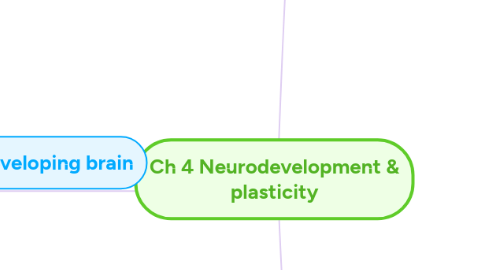
1. The developing brain
1.1. Neurulation
1.1.1. 2 weeks: flat cell sheet oEndoderm: internal organ lining (viscera) oMesoderm: bones, muscles oEctoderm: skin, NS
1.1.2. Neural tube sinks under skin: oAnterior: brain oRest: spinal cord
1.1.3. Tube cavity: become CSF cerebrospinal fluid
1.2. Neurogenesis
1.2.1. 1.Proliferation: cell generation, production of new cells
1.2.2. 2.Migration: cells move to destined region, radially (vertical, inside out) or (horizontal), guided by chemicals (immunoglobulins, chemokines)
1.2.3. 3.Differentiation: development of distinct cell features
1.2.4. 4. Myelination: development of insulating sheaths on axons
1.2.5. 5.Synaptogenesis: formation of synapses
1.2.6. Adult neurogenesis at a lower rate: -Olfactory bulb (mouse) : direct exposure to toxins -Hippocampus (humans) : memory
1.2.7. Axonal connection specific, not random: -Roger Sperry: cut frog optic nerve=regenerated to tectum - Cut nerve again, rotated eye 180˚ = axons attach to original position – frogs with new, inverted visual fields
1.2.7.1. Chemically guided trail: -axons match complementary target receptors -Some attract (chemoattractants), others repel (chemorepellent)
1.2.7.2. Use it or lose it: -Many synapses & neurons initially: pruned删除 via trial & error -Successful axon-muscle synapse: target cell releases nerve growth factor (NGF) (NGF cancel the apoptosis) -Promotes neuron survival (neurotrophin, e.g. brain derived neurotrophic factor, BDNF)
1.2.8. Developing brain susceptible to damage
1.2.8.1. Apoptosis (programmed cell death) vs necrosis (death via injury/toxicity)
1.2.8.2. Fever, maternal stress, low blood glucose levels stunt neuron proliferation
1.2.8.3. Alcohol: impacts all stages of neurogenesis -Inhibits glutamate (excitatory), facilitate GABA (inhibitory) receptors = lack of excitation = apoptosis -Cells compensate: build more glutamate receptors when alcohol comes in, when alcohol stop = excess glutamate overexcites cells = necrosis
1.2.9. Timing crucial for cortex differentiation
1.2.9.1. Turn right when see light, Rewired auditory cortex receiving visual input interprets it as vision, not sound (e.g. young vs old immigrant speech accent)
1.2.10. Brain enhancement or adaptation
1.2.10.1. Blind people: -Enhanced touch and audition, but only those practiced or attended to (e.g. fingers vs lips) -Some cortical reorganization (blind use occipital cortex in feeling task, unlike sighted)
1.2.10.2. Musicians: -Larger relevant brain areas (e.g. finger portion of somatosensory cortex) -Overuse: brain region overlap,stimulation of adjacent area activation (e.g. musician’s cramp)
1.2.11. Adolescence vs Elderly:
1.2.11.1. Adolescene: -Impulsive, immediate gratification, risk seeking, rebellious behaviour -Rapidly maturing amygdala & prefrontal cortex (25 years), most vulnerable to stress at this point
1.2.11.2. Elderly: -Declining memory & reasoning – language (besides naming) & attention usually retained till 80s -Compensate by engaging additional brain areas
2. Genetics in development
2.1. Mendelian genetics
2.1.1. DNA serves as template for the synthesis of RNA
2.1.2. messenger RNA (synthesis of protein)
2.1.3. DNA: adenine, guanine, cytosine & thymine
2.1.4. RNA: adenine, guanine, cytosine & uracil
2.1.5. Mendel: inheritance occur through genes
2.1.6. BB both chromosomes (homozygous), Bb unmatched (heterozygous)
2.1.7. dominant vs recessive
2.1.8. Not all single genes give rise to a single trait (eye colour: 10 genes)
2.1.9. Sex-linked genes: traits carried on X chromosome -Recessive sex-linked traits more common (colour blindness) Men more easy kena
2.1.10. Sex-limited genes: traits on autosomal chromosomes, expressed only in one sex (e.g. breast, chest hair)
2.1.11. Mutation: permanent change in DNA sequence (deletion, duplication), heritable
2.1.12. Heritability: trait variation largely dependent on genetics
2.1.13. Epigenetics: how environment influences trait variations and gene activations
2.1.14. Certain traits vestigial (“leftover”): goosebumps, some functional (limited youth: make way)
3. Brain plasticity after damage
3.1. Neuroplasticity
3.1.1. Ability to change with experience: -Age (childhood), region (hippocampus) -Deprivation (blind: rearrangement), enrichment (musician: enlargement)
3.2. Plasticity after damage
3.2.1. Closed head injury: brain “unpunctured” (mild or severe concussion)
3.2.2. Stroke: interruption of blood flow to brain: -Ischemia (drought): blood clot or arterial obstruction -Hemorrhage (flood): bleeding from ruptured artery
3.2.3. Pressure on brain -Hematoma: blood pool outside blood vessel -Edema: fluid accumulation -Both promote more strokes
3.2.4. A lack of blood = damage even if blood flow is restored -Neuronal ionic changes in region (glutamate, calcium) = apoptosis, necrosis -Microglia release neurotrophins: save remaining cells
3.2.5. Acute (stabilization from metabolic effects), then later stages (reorganization) of recovery
3.3. Acute stage treatment
3.3.1. timely treatment most important
3.3.2. Is stroke hemorrhagic/ischaemic? -Tissue plasminogen activator (tPA): destroys blood clots, off sets worsening hemorrhage (less common, more fatal) -Cool the brain (hypothermia): slows processes, reduces inflammation, apoptosis/necrosis
3.4. Later stage treatment
3.4.1. Stimulating regrowth: -Limited: CNS environment inhibits regeneration (scar, glia, myelination) -Diaschisis: decreased function of surviving neurons after damage in distal region -Synaptogenesis & responsiveness initially increases to compensate (denervation supersensitivity, collateral sprouting, new branches of axon) *denervation supersensitivity: one part damage , remaining synapse become more responsive -Side effect, mild touch=pain
3.4.2. Rehabilitation
3.4.2.1. Use weakened limb to maintain function (prevent deafferentation)
3.4.3. Recovery better for: -Younger patients -Earlier treatment -Traumatic (concussion) injuries -Personality (optimistic) & somewhat intelligence (high) -Sinistrals & females (more bilateral brains)
3.5. Phantom limb
3.5.1. Pain in amputated limb in the absence of sensory input
3.5.2. But input not just sensory, also proprioceptive (cortical proximity)
3.5.3. Crosswiring: mismatch in sensory input & feedback (memory vs actual pain)
3.5.4. Cured with mirror therapy (Ramachandran): “return” of limb, vision overrides touch
